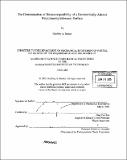| dc.contributor.advisor | Nam Pyo Suh. | en_US |
| dc.contributor.author | Becker, Geoffrey A | en_US |
| dc.contributor.other | Massachusetts Institute of Technology. Dept. of Mechanical Engineering. | en_US |
| dc.date.accessioned | 2006-05-15T20:36:33Z | |
| dc.date.available | 2006-05-15T20:36:33Z | |
| dc.date.copyright | 2005 | en_US |
| dc.date.issued | 2005 | en_US |
| dc.identifier.uri | http://hdl.handle.net/1721.1/32879 | |
| dc.description | Thesis (S.B.)--Massachusetts Institute of Technology, Dept. of Mechanical Engineering, 2005. | en_US |
| dc.description | Includes bibliographical references (leaves 38-40). | en_US |
| dc.description.abstract | Bio- and hemocompatibility are some of the driving forces behind medical device creation and materials science in this day and age. An experimental study was performed to test whether a geometrically altered surface of Poly(dimethylsiloxane), or PDMS, was found to be more or less hemocompatible than a flat, unaltered film of PDMS. In this case, the alteration was the addition of micron-scale posts sticking perpendicular to the surface, creating a superhydrophobic "bed of nails" effect. Once the specific altered surfaces were chosen, designed using Photolithography, and manufactured via a polymer casting process, a platelet adhesion assay was developed to assess the relative hemocompatibility of the surface via number of platelets counted on the surface of the altered vs. unaltered PDMS. Apparent contact angles of blood and Platelet-Rich Plasma (PRP) on the surface were also measured. The final instance of this experiment yielded positive results: The geometrically altered surface yielded less debris and platelet adhesion than did the flat PDMS surface, indicating an improvement in the hemocompatibility of PDMS via this process. | en_US |
| dc.description.statementofresponsibility | by Geoffrey A. Becker. | en_US |
| dc.format.extent | 40 leaves | en_US |
| dc.format.extent | 2823292 bytes | |
| dc.format.extent | 2823008 bytes | |
| dc.format.mimetype | application/pdf | |
| dc.format.mimetype | application/pdf | |
| dc.language.iso | eng | en_US |
| dc.publisher | Massachusetts Institute of Technology | en_US |
| dc.rights | M.I.T. theses are protected by copyright. They may be viewed from this source for any purpose, but reproduction or distribution in any format is prohibited without written permission. See provided URL for inquiries about permission. | en_US |
| dc.rights.uri | http://dspace.mit.edu/handle/1721.1/7582 | |
| dc.subject | Mechanical Engineering. | en_US |
| dc.title | The determination of hemocompatibility of a geometrically-altered poly(dimethylsiloxane) surface | en_US |
| dc.type | Thesis | en_US |
| dc.description.degree | S.B. | en_US |
| dc.contributor.department | Massachusetts Institute of Technology. Department of Mechanical Engineering | |
| dc.identifier.oclc | 62588883 | en_US |
